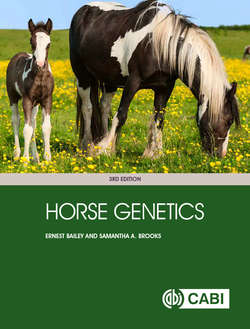Читать книгу Horse Genetics - Ernest Bailey - Страница 33
На сайте Литреса книга снята с продажи.
Asses
ОглавлениеAsses evolved in northern Africa. Following domestication, the donkey is found throughout the world because of its usefulness in agriculture. The Somali wild ass continues to exist in the wild in regions of Ethiopia and Eritrea. At present, the number of Somali wild asses may be less than 200 and the species is considered critically endangered (Moehlman et al., 2008c).
The ass karyotype differs numerically from that of the horse by just a single chromosome pair, but the morphology and banding patterns of the individual chromosomes are quite different from those of the horse. Chromosome painting studies have demonstrated large numbers of rearrangements in genome organization when comparing asses with horses (Raudsepp and Chowdhary, 2001). The karyotypes of the Somali wild ass (Fig. 3.5) and the domestic ass cannot be distinguished. A simple chromosome polymorphism has been described several times that involves the same large metacentric chromosome (Benirschke and Ryder, 1985; Bowling and Millon, 1988). Studies of mitochondrial DNA from the extant asses and museum specimens of the extinct Nubian wild ass (E. africanus africanus) indicated that the domestic donkey appears to have descended from the Nubian wild ass and another unknown, ancestral species, but to be distinct from the Somali wild ass (Kimura et al., 2011).
Fig. 3.5. Somali wild ass (E. africanus somaliensis) (picture provided by Zoological Society of San Diego).
